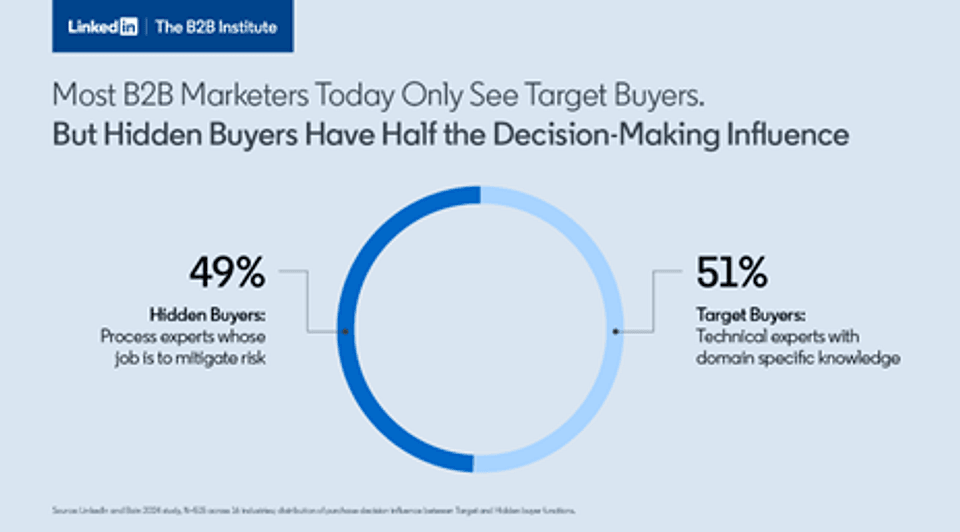Since to be contrarian is to go against what the majority are saying, contrarianism has always been a big part of New Narrative’s raison d’être (it’s behind our name, for one thing). It’s always our goal to help clients stand out by expressing bold, at times provocative, views, and finding new ways of reaching select audiences.
I’d like to say we always succeed. Yet in reality, it’s sometimes hard to convince clients of the need for novelty, given the risk anyone takes in standing out. Nevertheless, it’s a risk that’s increasingly important for B2B marketers to take.
Stand out or sink
Why? According to Jennifer Shaw-Sweet, EMEA Lead at LinkedIn’s B2B Institute (and therefore someone who knows a thing or two about contrarian marketing), going against the grain can solve several interlinked problems that B2B marketers face, as she explained in an illuminating presentation of the institute’s recent research at an event in London earlier this summer.
The first of these problems is that most buyers of B2B services aren’t actually ready to buy at any one time. That doesn’t mean you should forget about trying to reach them – it means you need to make sure your brand is memorable enough for them to consider you when they are prepared to take the plunge. These future buyers are future revenue streams, and memorable brand marketing is essential to secure them.

If you’re not memorable, as LinkedIn explains, you won’t make the very short shortlist that B2B buyers will have mentally prepared when they get ready to open their wallets. Apparently, 86% of buyers have their choices predetermined on day one, and they typically only shortlist around three to four brands to evaluate in earnest.
These two problems explain why all the successful B2B brands you know use the brashest messaging, most vivid colours, craziest stories and catchiest jingles in the marketing world, right? Okay, actually they don’t. Insurers, banks, accountancies, cloud services firms and the like aren’t generally known for their screwball antics. In fact, the brand colour schemes for many run the gamut from light blue all the way to dark blue.
LinkedIn (itself no stranger to blue) is pretty scathing of this approach, warning that its data shows brand colours and imagery are often misattributed, if they are recalled at all. “Without distinctiveness,” it warns, “your ad dollars are not only being wasted, they are driving a mental advantage for your biggest competitors.”
Where contrarianism meets conservatism
There must be a good reason for this resistance to exceptionalism, if it risks forgoing future sales impact? Yes, and its name is risk aversion – the other side of the B2B buyer coin.
LinkedIn suggests that B2B marketers focus on the expert, functional side of the buying committee with appeals to expertise, suitability and excellence of service, but often forget about those who prioritise process and compliance. Yet these people have almost as large a say as the experts in the buying process, and may ultimately hold the veto power.

I don’t disagree that a lot of marketing effort is targeted at the technical experts – those who read reports, attend webinars and in LinkedIn’s words, leave a digital trail. I would suggest, though, that the safe, generic brand and marketing tendencies that LinkedIn decries are the result of attempting to cater, even if subconsciously, to the “hidden,” process-driven decision-makers.
Because their primary role often has to do with mitigating risks, these people are all but certain to feel more comfortable with a staid, boring (and probably blue-tinted) brand than a wacky, parti-coloured one adorning a zany cartoon mascot. Safe and boring, especially on the B2B level, pays off in reassurance (for the process people) what it loses in memorability (for the experts and others).
Lead thoughts, gain memorability
Whatever strategies marketers adopt, it seems, there’s a tradeoff. What’s a B2B brand to do? The only answer, as far as we’re concerned, is genuine thought leadership. That is, to share views and insights of such originality and substance that they get reported by others speaking to – or part of – the same audience, thereby getting them to do some of the hard work of raising your brand profile, without resorting to gimmicks. As this blog proves, LinkedIn has done this to excellent effect, blue brand or no.
Contrarianism – at least in this context – doesn’t mean arguing for the sake of it, or sticking your neck out on a commercially sensitive topic, which might be original and earn attention – but of the wrong kind.
Instead, a commitment to tackling issues of interest to the audience (rather than nakedly in service of your commercial aims), and to offering informed and intellectually credible guidance on complex topics, are the hallmarks of genuine thought leadership.
A more thorough definition of this overused term will have to wait for a future blog … partly because there are so many on this very issue it is mighty hard to be original or distinctive about it. But for marketers struggling to strike the difficult balance between contrarianism and risk aversion, cultivating these qualities is a good place to start.
World-class communications strategy and execution
Contact us to get started